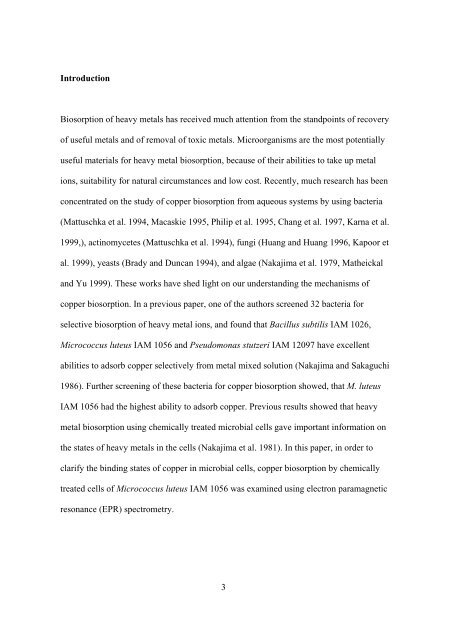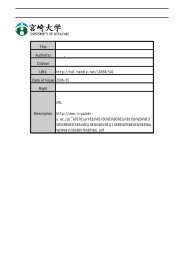Micrococcus luteus - 宮崎大学
Micrococcus luteus - 宮崎大学
Micrococcus luteus - 宮崎大学
You also want an ePaper? Increase the reach of your titles
YUMPU automatically turns print PDFs into web optimized ePapers that Google loves.
Introduction<br />
Biosorption of heavy metals has received much attention from the standpoints of recovery<br />
of useful metals and of removal of toxic metals. Microorganisms are the most potentially<br />
useful materials for heavy metal biosorption, because of their abilities to take up metal<br />
ions, suitability for natural circumstances and low cost. Recently, much research has been<br />
concentrated on the study of copper biosorption from aqueous systems by using bacteria<br />
(Mattuschka et al. 1994, Macaskie 1995, Philip et al. 1995, Chang et al. 1997, Karna et al.<br />
1999,), actinomycetes (Mattuschka et al. 1994), fungi (Huang and Huang 1996, Kapoor et<br />
al. 1999), yeasts (Brady and Duncan 1994), and algae (Nakajima et al. 1979, Matheickal<br />
and Yu 1999). These works have shed light on our understanding the mechanisms of<br />
copper biosorption. In a previous paper, one of the authors screened 32 bacteria for<br />
selective biosorption of heavy metal ions, and found that Bacillus subtilis IAM 1026,<br />
<strong>Micrococcus</strong> <strong>luteus</strong> IAM 1056 and Pseudomonas stutzeri IAM 12097 have excellent<br />
abilities to adsorb copper selectively from metal mixed solution (Nakajima and Sakaguchi<br />
1986). Further screening of these bacteria for copper biosorption showed, that M. <strong>luteus</strong><br />
IAM 1056 had the highest ability to adsorb copper. Previous results showed that heavy<br />
metal biosorption using chemically treated microbial cells gave important information on<br />
the states of heavy metals in the cells (Nakajima et al. 1981). In this paper, in order to<br />
clarify the binding states of copper in microbial cells, copper biosorption by chemically<br />
treated cells of <strong>Micrococcus</strong> <strong>luteus</strong> IAM 1056 was examined using electron paramagnetic<br />
resonance (EPR) spectrometry.<br />
3




